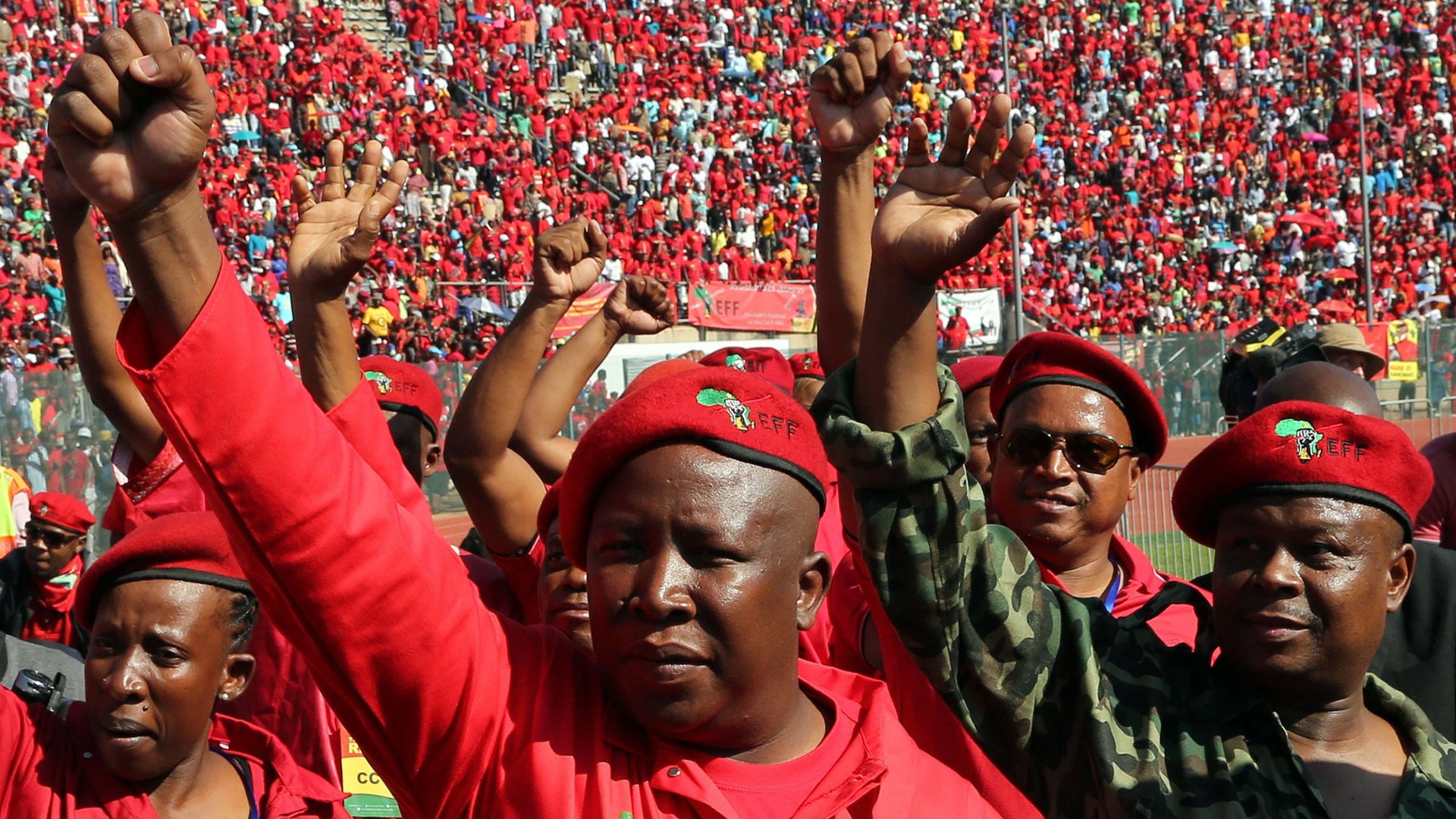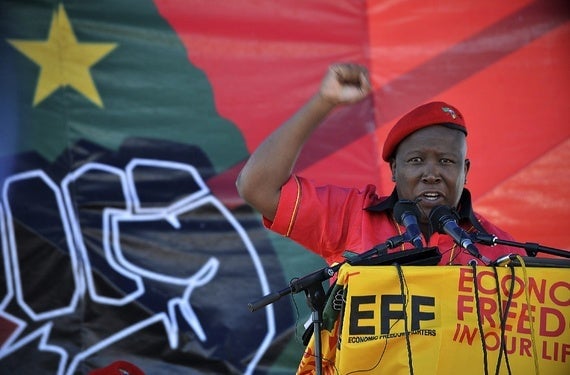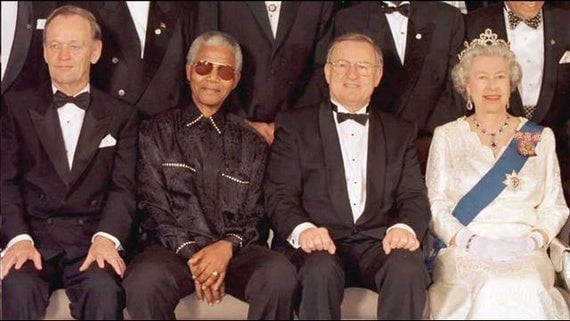South Africa’s freedom fighters let their clothes speak for themselves
Last week, a sea of red jumpsuits surfaced in Johannesburg. Nearly 300 supporters of the Economic Freedom Fighters (EFF)—a self-declared Marxist-Leninist political party that has formed in opposition to the dominant African National Congress (ANC), and adopted red overalls as its uniform—gathered at the legislative building of South Africa’s Gauteng province. They were there to protest the expulsion of eight EFF members of the provincial legislature who were expelled from the building on July 1 for wearing the party uniform.


Last week, a sea of red jumpsuits surfaced in Johannesburg. Nearly 300 supporters of the Economic Freedom Fighters (EFF)—a self-declared Marxist-Leninist political party that has formed in opposition to the dominant African National Congress (ANC), and adopted red overalls as its uniform—gathered at the legislative building of South Africa’s Gauteng province. They were there to protest the expulsion of eight EFF members of the provincial legislature who were expelled from the building on July 1 for wearing the party uniform.
The EFF’s overalls are, in and of themselves, a radical political statement. According to party rhetoric, the jumpsuits are meant to express solidarity with the country’s domestic workers and manual laborers. Their red color represents a connection not only to communist parties past, but also to the blood of laborers, including 34 platinum miners who were massacred by police in Marikana in 2012, at the very site where the EFF announced its formation one year ago.
Though the EFF only won 6% of the vote in this year’s general election, the party is quickly gaining momentum, and its message of wealth redistribution has mass appeal in a society that remains deeply unequal—with 10% of the population accounting for roughly half the nation’s income, and 47% living below the poverty line.
Julius Malema, the EFF’s fiery leader, showed up at last week’s protest with his own twist on the uniform, combining the party’s trademark red shirt and red beret with a checkered Palestinian scarf, worn in support of Gaza’s besieged Palestinians. He looked every bit the part of a communist revolutionary.

But Malema remains haunted by corruption allegations and a penchant for conspicuous material consumption. During a campaign stop in April, his advocacy for the poor rang hollow to the journalist Sibongakonke Shoba, who pointed out the literally glaring example of sunlight glinting off the buckles of his Louis Vuitton loafers, which retail for around $700. Journalists mocked Malema’s “bling shoes,” with one asking, in jest, if Malema was the “misunderstood Cinderella” of South African politics.
The gap between Malema’s rhetoric and dress has long invited critiques of the divisive politician as a champagne socialist. In 2010, when Malema was still making his name as an orator in the ANC’s Youth League, his Gucci suits and $24,000 Breitling watch often clashed with his populist message, which advocated for the nationalization of the country’s privately owned mines and the redistribution of its wealth and land. While his platform encompassed a number of causes that might, theoretically, appeal to the left, he alienated many supporters not only through his flamboyant style, but also through his blunt, boastful words, which at times crossed over into hate speech, according to his critics. His enthusiasm for leading sing-alongs of tunes like “Shoot the Boer” enraged the white Afrikaner minority, and his victim-shaming comments about a woman who had accused President Jacob Zuma of sexual assault enraged many others.
These incidents, along with Malema’s frequent clashes with Zuma himself, eventually led to Malema’s expulsion from the ANC in 2011, at which point he claimed that he was “finished politically.” Malema, who had been active within the ANC since he was nine years old, said he would instead devote himself to cattle-farming. ”I have 20 cattle now,” he said, in a modest statement of resignation, ”we will breed them, take them to the abattoir, slaughter them, and then sell the meat.”
Malema’s reputation suffered further damage soon afterward when a forensic audit of his assets suggested that he was receiving kickbacks from government contractors. According to the report, he was also spending more than $30,000 of those funds on designer clothes.
Yet even as Malema fell from his position of influence within the ANC, he continually worked to reinforce his connections to the party’s more radical past. Before 2013, he hadn’t had much success. When Malema cast his plans for nationalizing mines as a continuation of the Mandela family’s legacy, Winnie Madikizela-Mandela, Nelson Mandela’s ex-wife, responded that she was not, like Malema, the type of populist who “exploits” the poor and uneducated in order to sustain “a luxury lifestyle and what we now call bling.”
Malema’s connections to the Mandela family may be tenuous at best. But since his self-reinvention as the jumpsuit-clad leader of the EFF, Malema has proven increasingly skilled at using his own sense of style, both in rhetoric and in cloth, to his advantage—a skill he shares with Mandela.
At Mandela’s memorial service in 2013, his university classmate and supporter, George Bizos, remembered him as “the best dressed student, always.” Like Malema, Mandela often donned designer suits and shiny shoes as part of his everyday wardrobe. Yet Mandela never confined himself to Western dress. When the future president was arrested, in 1962, he chose to appear at his trial in traditional tribal dress, in order to symbolize his position “as a black man in a white man’s court.” His most iconic clothing choice came on the day that he stepped onto the parliament floor for the first time in 1994. Though Mandela wore a three-piece suit to his inauguration, he chose for his entry into parliament a distinctive silk batik shirt. The colorful “Madiba” shirt, and the 150 variations that were specially designed for him throughout his career, became a potent symbol of the post-apartheid government. And though the shirt was not considered traditional South African garb, it nonetheless came to represent the nation when the president traveled abroad, particularly when he sported a black version of the shirt during his first visit with the queen of England in 1995.

Even after Mandela’s tenure as president, he continued to make calculated sartorial choices. In 2002, his decision to wear a T-shirt emblazoned with the words “HIV positive” served as a symbolic victory for the country’s AIDS activists. It also helped rescue Mandela’s own legacy given his reluctance to take action on the health crisis during his time in office (Mandela’s successor, Thabo Mbeki, continued to deny the viral spread of AIDS and prevented thousands of HIV-positive South Africans from accessing antiretroviral drugs).
The 33-year-old Malema, who is a former political-science major, knows this history—and he seems intent on harnessing it to his advantage. When asked about why the EFF refused to remove their workers’ uniforms in the Gauteng legislature, his response echoed that of Mandela in 1962:
To you proper is white, to you proper is European. We are not white, we are going to wear those uniforms. … We are defying colonialist decorum. We are not English-made. We are workers, and we are going to wear those clothes and we are unapologetic about it.
The official reason for the EFF’s removal from the legislature has less to do with the workers’ uniforms than Malema’s response suggests. The legislature does not allow political slogans on its premises and the EFF motto “asijiki” (“we will not turn back”), which was sewn into the EFF jumpsuits worn in Gauteng, violates this rule. When the EFF representatives wore uniforms that did not bear the party insignia, they were allowed into the National Assembly. Still, by turning the conversation to “colonialist decorum,” Malema has found a strong line of attack against the ANC—one that has been embraced, for instance, by former ANC activist Raymond Suttner.
Malema has also learned how to turn critiques of his image against his enemies. He has not only distanced himself from the cartoonist Zapiro’s caricature of him as a tantrum-prone manchild in diapers, but also re-appropriated it. In Gauteng, his supporters hoisted a diapered mannequin with the name of South Africa’s president scrawled above its butt.
His enemies have returned the favor. This week, ANC secretary-general Gwede Mantashe likened Malema to Hitler, drawing comparisons between the EFF’s red shirts and the Nazis’ brown shirts. Meanwhile, the ANC has reportedly begun sending their own supporters to the streets wearing red berets, in order to “confuse the enemy.”
Amid all of this inflammatory rhetoric and imagery, the EFF may still lack the political integrity to translate its message into legislative change. As the Cameroonian theorist Achille Mbembe wrote in an article published on Friday in South Africa’s Mail & Guardian, “it might be that [the EFF] has no real principles of its own and simply dresses itself in the ideological costume it thinks will be most attractive to the masses.” Nonetheless, the party’s oppositional stance remains important, Mbembe insists, as a “dramatic manifestation of the structural incompleteness of South Africa’s democracy.” This manifestation may remind South African voters that “political equality without property is not only fragile, but also fictitious.”
Some international commentators are more optimistic than Mbembe in regards to Malema’s potential. Oxford University professor Jonny Steinberg has suggested that the current global discourse on economic inequality might be uniquely suited to Malema’s message, predicting that “someone will soon give Economic Freedom Fighters leader Julius Malema a copy of [Thomas] Piketty’s book; Malema was born to use it to good effect.”
If Malema does style himself as a political heir to the French economist, he may have to ditch his French designer shoes.